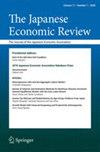基于相互作用的总投资波动实证研究
IF 1.5
4区 经济学
Q2 ECONOMICS
引用次数: 3
摘要
本文认为,在没有外生总冲击的情况下,企业间的相互作用占总投资波动的很大一部分。我们首先用意大利公司的面板数据集实证地证明,从事块状投资的公司比例遵循非正态的双边指数分布。然后,我们提出了一个简单的部门模型,该模型产生了由公司在一个地区内的块状投资的互补性产生的双边指数分布。通过对企业水平的互补性估计进行校准,该模型能够产生在总体水平上观察到的双边指数波动。本文章由计算机程序翻译,如有差异,请以英文原文为准。
An Empirical Study of Interaction-Based Aggregate Investment Fluctuations
This paper argues that interactions of firms account for a sizable part of fluctuations in aggregate investments without exogenous aggregate shocks. We first establish empirically that the fraction of firms that engage in a lumpy investment follows a non-normal, two-sided exponential distribution across region-year with a panel data set of Italian firms. We then present a simple sectoral model that generates the two-sided exponential distribution that arises from the complementarity of the firms’ lumpy investments within a region. Calibrated by the firm-level estimate of complementarity, the model is capable of generating the two-sided exponential fluctuations observed at the aggregate level.
求助全文
通过发布文献求助,成功后即可免费获取论文全文。
去求助
来源期刊

Japanese Economic Review
ECONOMICS-
CiteScore
2.70
自引率
0.00%
发文量
15
期刊介绍:
Started in 1950 by a group of leading Japanese economists under the title The Economic Studies Quarterly, the journal became the official publication of the Japanese Economic Association in 1959. As its successor, The Japanese Economic Review has become the Japanese counterpart of The American Economic Review, publishing substantial economic analysis of the highest quality across the whole field of economics from researchers both within and outside Japan. It also welcomes innovative and thought-provoking contributions with strong relevance to real economic issues, whether political, theoretical or policy-oriented.
 求助内容:
求助内容: 应助结果提醒方式:
应助结果提醒方式:


